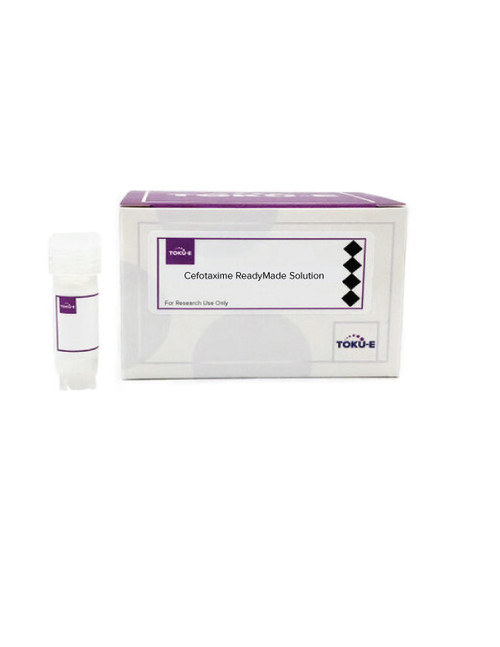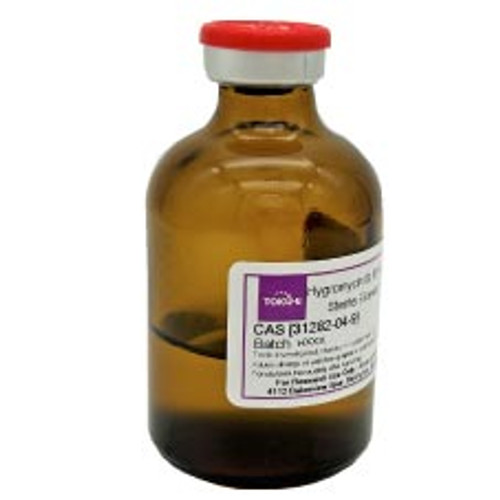Streptomycin ReadyMadeTM Solution is provided as a sterile-filtered solution of Streptomycin Sulfate formulated in water at a concentration of 100 mg/ml. It has been filter-sterilized using a 0.22 μm filter.
Streptomycin is an aminocyclitol glycoside antibiotic discovered by Salman Waksman, Albert Schatz, and Elizabeth Bugie at Rutgers University in 1943 and patented in 1948. Streptomycin is isolated from Streptomyces griseus and shows bacteriostatic activity at low concentrations and bactericidal activity at higher concentrations against mycobacteria and Gram-negative bacteria. It is less active against Gram-positive bacteria. Streptomycin Sulfate has been found to be effective against certain β-lactam sensitive VRE or vancomycin resistant Enterococcus species; a glycopeptide antibiotic resistant "superbug”.
Streptomycin is a protein synthesis inhibitor that acts by binding to the 30S ribosomal subunit at the S12 protein thereby inducing a misreading of the genetic code, inhibiting the initiation of translation of DNA, which then results in death for a susceptible bacterium. Streptomycin has also shown activity as a miRNA inhibitor, that is capable of down-regulating miR-21, a miRNA that is overexpressed in a wide variety of cancers.
We also offer:
- Streptomycin Sulfate (S008)
| Mechanism of Action | Streptomycin is a protein synthesis inhibitor. It binds to the small 16S rRNA of the 30S subunit of the bacterial ribosome, interfering with the binding of formyl-methionyl-tRNA to the 30S subunit. This leads to codon misreading, eventual inhibition of protein synthesis and ultimately death of microbial cells through mechanisms that are still not understood. Speculation on this mechanism indicates that the binding of the molecule to the 30S subunit interferes with 50S subunit association with the mRNA strand. This results in an unstable ribosomal-mRNA complex, leading to a frameshift mutation and defective protein synthesis; leading to cell death. |
| Spectrum | Streptomycin Sulfate is highly active against Gram-negative and mycobacterium, and less active against Gram-positive bacteria. Streptomycin Sulfate has been found to be effective against certain β-lactam sensitive VRE or vancomycin resistant Enterococcus species; a glycopeptide antibiotic resistant "superbug". It is also active against mycobacteria. |
| Microbiology Applications |
Streptomycin Sulfate is commonly used in clinical in vitro microbiological antimicrobial susceptibility tests (panels, discs, and MIC strips) against Gram-positive and Mycobacterium microbial isolates. Medical microbiologists use AST results to recommend antibiotic treatment options. Representative MIC values include: Mycobacterium tuberculosis 1 µg/mL – 2 µg/ml For Additional MIC values for Streptomycin Sulfate, visit our Antimicrobial Index.
Media Supplements STAA Agar - STAA Selective Supplement STA Agar - STA Selective Supplement |
| Plant Biology Applications |
Streptomycin has been used in crop protection to prevent fire blight, soft rot caused by Pectobacterium species, bacterial blight caused by Pseudomonas cichorii, fruit-spotting in apples and pears, and bacterial spot in peppers and tomatoes caused by Xanthomonas spp. (McManus et al. 2002). |
| Electrophoresis Applications | When purifying protein from a biological extract, Streptomycin Sulfate is sometimes added as a means of removing nucleic acids. Since it binds to ribosomes and precipitates out of solution, it serves as a method for removing rRNA, mRNA, and even DNA if the extract is prokaryotic. |
| Cancer Applications | Streptomycin Sulfate can down-regulate the levels of mature miR-21, a miRNA that is overexpressed in a wide variety of cancers and has been causally linked to cellular proliferation, apoptosis, and migration. Inhibition of miR-21 in MCF-7 breast cancer cells causes reduced cell growth. Streptomycin down-regulates miR-21 by binding to pre-miRNA (its precursor) and blocking the function of the Dicer enzyme, an essential step in miRNA maturation. |
| Molecular Formula | C21H39N7O12 · 1.5H2SO4 |
| References |
Bose D et al (2012) The tuberculosis drug Streptomycin as a potential cancer therapeutic inhibition of miR21 function by directly targeting its precursor. Angew. Chem. Int. Ed., 51:1019-1023 Davis BD (1987) Mechanism of bactericidal action of aminoglycosides Microbiol. Rev. 51(3):341-350 McManus PS, Stockwell VO, Sundin GW and Jones AL (2002) Antibiotic use in plant agriculture. Annu. Rev. Phytopathol. 40:443-465 Pfuetze KH et al (1955) The first clinical trial of Streptomycin in human tuberculosis. Am. Rev. Tuberc 71:752-754 Schatz et al (1944) Streptomycin, a substance exhibiting antibiotic activity against Gram-positive and Gram-negative bacteria. Proc. Exp. Biol. Med. 55:66-69 |








